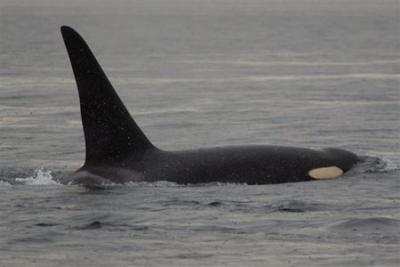
Big Tease

If anyone deserves an orca superpod on his birthday, surely our esteemed friend and VHP associate Mark Sears does. On October 8, a large group of Southern Residents traveled south in East Passage and cavorted mid-channel off Mark’s house at Lincoln Park. Alas, Mark had elaborate birthday plans with his human pod, so he was unavailable to obtain ID photos and collect samples.
At Chez VHP, we had a restless night by the hydrophone. Lacking Mark’s meticulous data on the number of whales present, as well as individual and pod identities, the precise configuration of the alleged superpod remains speculative at Loop deadline. Reliable spotters in West Seattle reported J Pod members, such as J26 (Mike) featured in this week’s photo. The group size suggests orcas from K and L Pods were likely present.
Our West Seattle friends last saw the Southern Residents still moving south, approaching the Vashon-Fauntleroy ferry lanes at sunset. We surmise that the orcas changed direction after dark; to our disappointment, we heard nothing on the hydrophone on the 8th. We understand, though – our endangered killer whale relatives must go where their food abounds. In fall, Southern Residents come here in search of Chum salmon. A profusion of Chum has yet to penetrate Vashon-Maury waters.
Please support the work of the Vashon Hydrophone Project (VHP): REPORT LOCAL WHALE SIGHTINGS ASAP TO 463-9041, as well as sick, injured, or dead marine mammals on Island beaches. Reporting directly to the VHP sustains an ongoing, accurate dataset of whale sightings for Vashon-Maury and nearby Central Puget Sound waters, initiated more than 30 years ago by researcher Mark Sears. Check for updates at Vashonorcas.org and send photos to Orca Annie at Vashonorcas@aol.com.
The VHP is the only whale conservation effort with a physical presence on Vashon–Maury. Your timely reports to us vastly improve our dataset for local waters. We garner the best information by talking to you, and from your detailed phone messages when we are in the field.
When reporting a sighting, the following information is helpful: date; time; location; species description, such as color or markings, size, number of animals, height of dorsal fins; travel direction and speed; are the whales spread out or tightly grouped? Particularly relevant for killer whale sightings: how many boats are near the orcas? Do not hesitate to contact us for help regarding what to include in a VHP sightings report.
Ferry riders and water taxi commuters, your calls to the VHP are important to our on-Island research effort. Give us a jingle when you see whales, and do not assume someone else is calling us. We rarely hear from folks on our boats, yet we are delirious and grateful when ferry staff or riders do call! Keep your binoculars and cameras handy – ‘tis the season.
- Login to post comments
